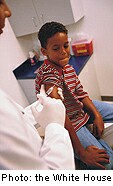
TUESDAY, March 9 (HealthDay News) — Children who get a flu shot help prevent flu from spreading in their communities, Canadian researchers say.
“By immunizing children and adolescents, there is a substantial protective effect in people who themselves were not immunized,” said lead researcher Dr. Mark Loeb, a professor of pathology and molecular medicine at McMaster University in Hamilton, Ontario.
“If you can immunize enough children and adolescents, you can achieve herd immunity and protect people who might not be vaccinated,” he added.
Each year in the United States, seasonal flu kills some 36,000 people and hospitalizes 200,000, according to the U.S. Centers for Disease Control and Prevention. Recently, the CDC expanded its recommendations for flu shots to include every child over 6 months and all adults.
The Canadian report is published in the March 10 issue of the Journal of the American Medical Association.
To see if vaccinating children could prevent the spread of flu in a community, Loeb’s team studied 49 Hutterite colonies in western Canada. From 60 to 120 people live in single family homes within each of these tightly knit religious communities, but they interact like an extended family, the researchers noted.
For the study, 947 youngsters between the ages of 3 and 15 received a flu vaccine, while 2,326 community members did not. The children were randomly assigned to get flu vaccine or hepatitis A vaccine, which was used as a control.
The researchers found that during the 2008-2009 flu season, 3.1 percent of unvaccinated people living in communities where children got flu shots came down with the flu, as compared to 7.6 of the people in communities where children didn’t get the flu shot.
The indirect protection from the flu granted by children getting vaccinated was 61 percent, Loeb’s team found.
Overall, in communities where children were vaccinated against the flu, 4.5 percent of adults who did or did not get vaccinated contracted flu compared with 10.6 percent of adults in communities where children did not get the flu vaccine. In that scenario, the overall protective effect of vaccinating children was 59 percent, the researchers added.
As a result, children and teens should be one of the groups targeted for flu vaccination, even when vaccine supplies are short, Loeb stressed.
“There is an additional benefit in immunizing children and adolescents in terms of reducing the spread of influenza in the community,” he said. “It doesn’t only benefit them, but it will protect their grandparents and older people in the community as well.”
Children remain contagious longer and are usually the first to get the flu, he noted. In addition, because they are in groups in school, they tend to spread the disease, he added.
Flu expert Dr. Marc Siegel, an associate professor of medicine at New York University Medical Center in New York City, said that “this is an important study, because it reflects something we already know.”
In Japan, where almost 90 percent of the children received flu vaccine, deaths from flu were cut by about 1 million over 25 years, Siegel said.
“The way to stop people from getting sick from the flu, and the way to stop the transmission is to target the groups that are most likely to spread it, which is kids,” he said. “Schools are petri dishes for flu.”
“Vaccination is a public health principal,” Siegel said. “Rather than just protecting your own self, it’s protecting everyone else,” he said.
This applies not just to seasonal flu, he noted, but also to pandemic flu, like the recent H1N1 swine flu.
More information
For more on the flu, visit the U.S. Centers for Disease Control and Prevention.

